Pennsylvania Supreme Court Redraws State’s Gerrymandered Congressional Districts
The Pennsylvania Supreme Court has redrawn the state's Congressional Districts based on its recent ruling finding the current map to be unconstitutional partisan Gerrymandering. It makes a lot more sense than the map the state is currently using.
Just under a month ago, the Pennsylvania Supreme Court issued a ruling finding the current Congressional District map, drawn by a Republican-dominated state legislature in the wake of the 2010 election and the outcome of the 2010 Census to be unconstitutional under the terms of the state’s Constitution. In the Order that the Court issued at that time, the legislature was given a limited amount of time to come up with a new map that was in compliance with the state’s Constitution and the State Supreme Court’s ruling. The Republican legislature first responded to that ruling by taking the matter to the U.S. Supreme Court, asking the Court to put a hold on the state Supreme Court’s ruling pending appeal, but the Supreme Court declined to do so. The Court also stated that it would submit a map of its own if the legislature proved unable to come up with an acceptable map by the time the deadline passes. That deadline passed earlier this month with the legislature and the state’s Democratic Governor unable to come up with a map that either side could accept, so yesterday the Supreme Court issued a new order that includes a new map meant to address the Court’s ruling, and the resulting map seems likely to benefit Democrats to at least some extent:
The Pennsylvania Supreme Court drew new boundaries for the state’s congressional districts on Monday, releasing a map that, if it stands, could play a significant role in Democratic Party efforts to gain control of the House of Representatives in the midterm elections.
The court ruled in January that the state’s existing congressional map was an illegal partisan gerrymander that “clearly, plainly and palpably” violated the State Constitution. Under that map, Republicans have repeatedly won 13 of the state’s 18 House seats.
Election analysts said that the court’s new map could result in Democrats picking up three or four more seats, based on 2016 voting patterns. Pennsylvania is a perennial battleground in statewide elections, with voters supporting the two parties in roughly equal numbers. Critics have pointed to the current imbalance in House seats to highlight the unfairness of the current map, which was drawn in 2011 by Republicans.
Republicans in the State Legislature said they would challenge the new maps in federal court.
“Implementation of this map would create a constitutional crisis where the Pennsylvania Supreme Court is usurping the authority of the legislative and executive branches,” the leaders of the State Senate, Joe Scarnati, and the House, Mike Turzai, said in a statement. “This map illustrates that the definition of fair is simply code for a desire to elect more Democrats.”
But some election law experts said Republicans’ legal options were narrow. Earlier this month, the United States Supreme Court refused to block the remapping process.
The Pennsylvania high court’s actions have unfolded in a monthslong challenge to the existing congressional maps begun by the League of Women Voters. The court based its rulings on the State Constitution. The United States Supreme Court typically respects such decisions.
Separately, the United States Supreme Court is considering two challenges to partisan gerrymandering in Wisconsin and Maryland. Those cases were brought through federal courts, unlike in Pennsylvania. A major decision is expected later this year.
In drawing its maps — in part with the advice of a Stanford law professor, Nathaniel Persily, known for his expertise in legislative districting — the Pennsylvania Supreme Court rejected two competing maps drawn by Republicans and Democrats. The court said that unlike the offerings from partisan mapmakers, the districts it drew “follow the traditional redistricting criteria of compactness, contiguity, equality of population, and respect for the integrity of political subdivisions.”
The court’s maps split only 13 counties, compared with 28 counties that are divided under the maps currently in use, which were drawn in 2011 by Republicans in the Legislature. One of the current House districts is so tortured in its shape it earned the nickname “Goofy Kicking Donald Duck.”
Gov. Tom Wolf of Pennsylvania, a Democrat, who had exercised his power to veto a map offered by Republican lawmakers, welcomed the districts drawn by the court.
“I applaud the court for their decision and I respect their effort to remedy Pennsylvania’s unfair and unequal congressional elections,” Mr. Wolf said in a statement.
Election law experts said the new map created an equal number of districts favoring Democrats and Republicans. “It appears to be tilted toward neither political party,” Michael McDonald, an associate professor of political science at the University of Florida, said. “It looks more like a 9-to-9 division of the state.”
David Wasserman, the House of Representatives editor of the Cook Political Report, wrote on Twitter that the map had not simply undone the Republican gerrymander. It also took into account the fact that Democrats tend to cluster in cities and college towns, “actively helping Dems compensate for their natural geographic disadvantage.”
Some Republican incumbents instantly found themselves on shakier ground. Representative Ryan Costello’s Sixth District, which had been Republican-leaning territory in Southeastern Pennsylvania, has morphed into a Democratic-leaning district, Mr. Wasserman wrote.
And some open seats, like those currently held by the retiring Republicans Charlie Dent and Patrick Meehan, are now more likely to end up in Democratic hands, Mr. Wasserman said.
The question now is whether the map, issued in a 4-to-3 opinion that split along partisan lines, will hold.
Here’s what the current Pennsylvania Congressional District Map looks like: (Click image to enlarge)
By contrast, here’s what the map that the Court released yesterday looks like: (Again, click to enlarge)
The differences between the two maps could not be more apparent. Where the current maps include several districts that are drawn in bizarre patterns that in some ways mimic the shapes of districts we’ve seen from other states, especially in the areas around Philadelphia and Pittsburgh where there are significant minority populations centered in and around the respective urban areas, the revised map contains far more compact and geographically consistent districts. Many people will note that several of the districts in the revised map appear to be very large in size compared to their predecessors, but it’s worth keeping in mind that these districts include large parts of the state that are far less populous than other parts of the state. This is particularly true of the proposed 12th, 13th and 15th districts which take up most of Central Pennsylvania and, to a lesser extent, the proposed 14th, 8th, and 9th district which respectively consist of the southwestern and northeastern corners of Pennsylvania. Obviously, because of the lower population, it’s necessary to make these districts larger than some of their counterparts in and around Philadephia and Pittsburgh.
In addition to this, the other most notable thing about the revised map released by the Pennsylvania Supreme Court is the extent to which it has managed to take many of the most bizarrely shaped districts that are part of the current map and convert them into sizes and shapes that make far more sense than what is currently in existence. This is particularly evident in the area west of Philadelphia where the current 6th, 7th, 15th, and 17th Districts all have bizarre and seemingly nonsensical shapes that don’t make any geographic sense and which clearly seem to be designed to include or exclude areas that tend to favor one party or the other, In the revised map, the area previously covered by those districts is now largely taken up by the proposed 4th, 6th, 7th, 8th, and 9th districts, each of which covers far more sensible geographic regions. The same can be seen with regard to the 12th and 18th Congressional Districts that surround Pittsburgh, which makes up most of the 14th District. Those districts are replaced in the revised map by revised versions of the 17th and 18th Districts, with some of the areas that used make up each going to either the 13th District in the state’s northwest or the 13th and 15th Districts. Again, the revised maps suggestion seem to make far more sense than the districts the state has now. Additionally, it’s worth noting that all of these districts consist of more or less equivalent numbers when it comes to the actual population of either total residents or people of voting age, and they manage to do so in a way that makes sense and doesn’t seek to create a partisan advantage for one part or another.
Most of the press coverage of the revisions the Supreme Court has submitted is emphasizing the fact that the map would benefit Democrats, but it strikes me that this is the wrong way to look at it. Yes, it’s true that Democrats would be likely to become a larger part of the Pennsylvania Congressional Delegation if these changes are implemented, but that is largely a reflection of the fact that the current map was quite obviously designed to benefit Republicans. Indeed, the immediate reaction by several people who are more expert in Pennsylvania elections than I am or would ever claim to be have said that the most likely outcome in an ordinary election year based on the Supreme Court’s map would be a relatively even division of the state’s 18 Congressional Districts between Republicans and Democrats.
Not surprisingly Republicans in the Pennsylvania state legislature are already talking about taking the new Court-imposed map to Court:
Republicans say they’ll go to federal court this week to try to block new court-ordered boundaries of Pennsylvania’s congressional districts from remaining in effect for 2018’s elections.
Top Senate Republican lawyer Drew Crompton said Monday a separation of powers case will form the essence of the GOP’s argument. Crompton won’t say whether Republicans will go to a district court or the U.S. Supreme Court or what type of legal remedy they’ll seek.
But the case will involve making the argument the U.S. Constitution gives state legislatures and governors, not courts, the power to draw congressional boundaries.
Election law blogger and Law Professor at the University of California at Irvine Rick Hasen notes, however, that the GOP’s legal options are limited and probably fruitless:
Because this was a case decided under the state constitution by the state supreme court, the usual path for review of this case by the U.S. Supreme Court is limited. The only plausible argument I see is that the maps violate the Elections Clause of the Constitution, which vests in the state legislature the power to choose rules for congressional elections (unless Congress acts to preempt them).
The problem with this argument is that the Pa Republicans already went to the Supreme Court when the state supreme court announced a redistricting- and Republicans raised the very same argument. At the time it was raised, I called the argument a long shot, given a line of cases (most recently a 2015 case from Arizona) reading the word legislature much more broadly in the context of the elections clause. The emergency stay request went to Justice Alito, who denied it without even referring it to the Court. So he likely did not think much of it at the time.
Now it is quite possible that Pa. Republicans will go back to Justice Alito, arguing that things are even worse now that the state Supreme Court has adopted a map itself. That’s the job first and foremost for the legislature. But remember that the Pa. legislature did not even come up with an official passed plan for the state supreme court to reject. (A pair of legislative leaders had a plan, but it was not passed by the legislature.) This seems to give Pa. Republicans even less standing to complain about things. I expect something new filed with Justice Alito will get no further. (After all, we are even later into the election season.)
As Hasen goes on to note, there are also suggestions that Pennsylvania Republicans could seek to attack the Pennsylvania Supreme Court’s new map using essentially the same argument Hasen discusses above but doing so by filing a separate legal proceeding filed in Federal Court. If they chose this avenue, though, the legislators would likely run headlong into two legal problems that could ultimately doom their claims. The first problem is that the ordinary procedure for one who objects to the ruling of a state Supreme Court is to petition the Supreme Court of the United States to review the case. This is because the ruling of a state’s Supreme Court is deemed to be the highest legal authority of the respective state and its ruling are supposed to be given much of the same deference as a ruling from the U.S. Supreme Court. This is especially true when the state Supreme Court ruling in a particular case is based primarily if not exclusively on state law or the interpretation of that state’s Constitution. Challenging that kind of ruling via a collateral proceeding in Federal District Court is both highly unusual and not usually successful. Additionally, such an action would run headlong into something called the Rooker-Feldman Doctrine, which states that Federal Courts below the U.S. Supreme Court should not “sit in direct review of state court decisions unless Congress has specifically authorized such relief.” Under this doctrine, absent Congressional authority, which does not appear to exist in this case, or parties who have raised some compelling argument that the state court has somehow violated the Federal Constitution. As Hasen notes, that argument doesn’t seem to be particularly strong at all.
All of this is occurring, of course, in a legal climate where partisan redistricting appears to be under a particularly strong assault. The U.S. Supreme Court, for example, has accepted cases dealing with allegations of partisan gerrymandering from Wisconsin and Maryland. The Court has already heard oral argument in the Wisconsin case and will likely hear argument in the Maryland case later this term. Additionally, a three Judge panel of Federal District Court Judges handed down an opinion last month finding the district lines in North Carolina unconstitutional due to their partisan nature in a ruling that was similar to those issued in the Wisconsin and Maryland cases. The outcome in these three case at the Supreme Court level is unclear at this point but, based on the oral argument in the Maryland case, it appears that the outcome of the case is likely to come down to which side of the argument ends up being most persuasive to Justice Anthony Kennedy. During the oral argument in question, Kennedy appeared to be skeptical of the argument raised by the lawyers defending the existing districts in Wisconsin, but also expressed some skepticism about the use of the mathematical formula that the Plaintiffs relied upon in their analysis of the current Wisconsin map. The outcome of these cases will have a significant impact on the midterm elections in the states in question. If the case ends up being decided in favor of the Plaintiffs, it’s likely to lead to nationwide challenges to similarly drawn maps, While most of these challenges will not come soon enough to have an impact on this year’s midterms, they could have an impact in 2020 and, beyond that, on the redistricting that will have to take place after the 2020 census.
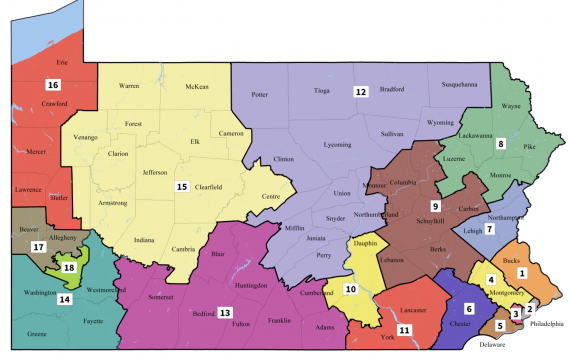
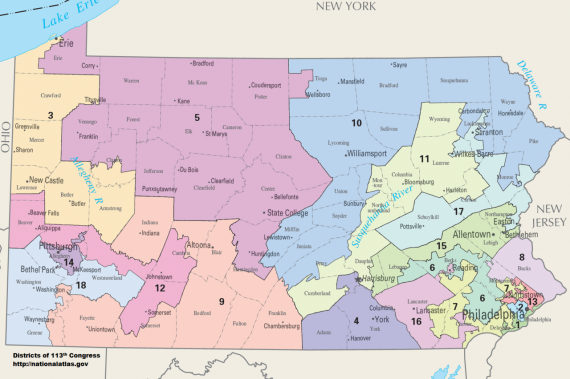

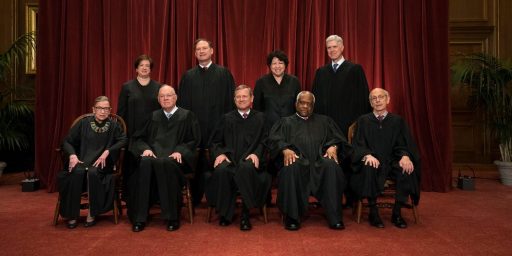
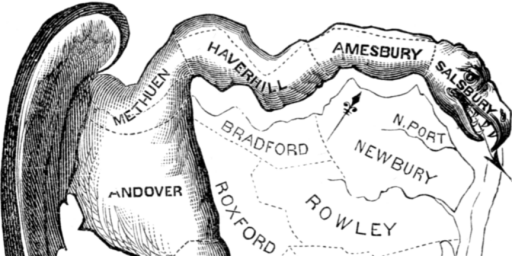

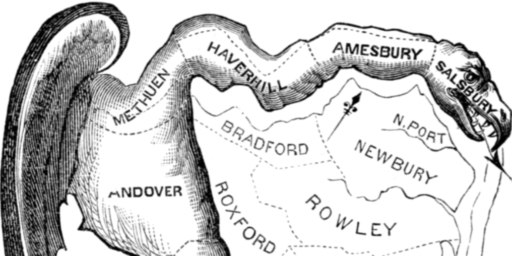
A huge problem for the PA Republicans here is that if you put those two maps in front of a five year old and asked them which one looked more fair, they would pick the Court’s map. Opposing that map is about as blatant a power grap (or attempt to hold on to existing power previously grabbed) as one can imagine.
So they rig the system to give themselves an advantage, and when that unfair way of doing things is fixed, they complain that they lose their advantage? No sh*t, morons! Pathetic tribalism. I guess the only question is whether this line of “reasoning” will be compelling to anyone that matters.
By the way, I certainly hope that Kennedy’s skepticism of a mathematical solution to this problem is just because he’s not a “math guy”. Skepticism regarding current gerrymandered districts is pretty easy to grasp.
@Gromitt Gunn: Apparently it was put in front of 5 years old on the Pennsylvania Supreme Court.
@reid: Was this a problem for you during the decades when the Democrat party gerrymandered districts to maintain three generations of Congressional and state house control. Didn’t think so. It wasn’t an issue for leftist back then either.
Speaking as a resident of one of the more fractal-looking districts around Philadelphia, it’s about time. I will miss my current Representative, who I think is a really good guy, but am perfectly happy to vote for someone else in exchange for sane district maps. Seriously, you have to look real close at the district map to see the little curly loop that cut my neighborhood out of the district that surrounds it. If that isn’t gerrymandering, I don’t know what is.
The Trumplicans are incensed that they aren’t going to be able to use the unfair map.
Denture Donnie:
Anything to maintain power.
The Pennsylvania map is still a partisan gerrymander, only now it has been drawn by the Democrat dominated state Supreme Court ( 5-2 Democratic majority) rather than the GOP majority legislature.
As Kevin Drum has said, gerrymandering became different when computers were introduced. Districts can be drawn with an unbelievable amount of bias, such as North Carolina, where Republicans won with 53% vs. 47% of the vote. Given the 13 seats, it would seem they should enjoy a 7-6 majority. Instead they get 10-3. The reality is that the people of North Carolina don’t want these extra Republicans but rather than run candidates the people would vote for, the Republican strategy in state after state is to take millions of dollars from billionaire political hobbyists like the Kochs and use it to pay for computer generated redistricting in order to skew the vote.
The Republicans made one last attempt to actually appeal to bring new voters to their fold during the 2012 election cycle with immigration reform. But the 5 decade old decision to pursue the racist Southern Strategy doomed that from the start. For all their lives Republican voters have known (explicitly or implicitly) that their Party is anti-Hispanic and they are fine with that. In fact, that may be one of the reasons they are attracted to the party. Hispanics make up only 16% of the population, while whites make up more than 4 times that, o every Hispanic voter they recruited lost them more of their existing voters who were angered by the outreach. In reality it’s even worse, as Republicans have both a larger share of whites, and those white are more likely to have negative views of Hispanics. So the reality is that the Republican Party is 86% White and only 6% Hispanic. Bringing that up to 8 to 10% would have a big effect on their electoral chances, except that it would probably cause significantly more of their white voters to stay home.
@Greg: yeah, and what about how the Democrats started the Ku Klux Klan? Checkmate Libtarts!
@David Gekko: you should look up what gerrymandering means.
@Greg: I’m sorry, you seem to have not waited for an answer from me. I want a completely unbiased solution, or at least as much as is possible. We have the technology now to come close to such a thing.
By the way, “it’s our turn to cheat” isn’t much of a defense.
@David Gekko: Except it isn’t. There are Philly districts which are 90% Dem. A real partisan gerrymander would have created tendrils snaking out of the city like an octopus to make lots of Dem +5% districts.
I guess when you are so used to the deck being stacked in your favor, playing without an advantage feels like a handicap…
@David Gekko:
You’re correct, but not in the way you think: the court’s new map actually still has a significant Republican Bias, both in terms of proportionality and voter efficiency gap. If there’s any complaint to be made, it’s that the court didn’t go far enough with their redraw.
It should also be noted that the Republican legislature was given a month to come up with a proposal of it’s own. Instead of doing so it spent that month throwing a tantrum like a bunch of petulant children and then came up with a map that was just as gerrymandered as the current one in an effort to deliberately thumb its nose at the court.
But then Petulant Children seems to be all the GOP is good for these days.
@David Gekko:
If was a map gerrymandered to favor Democrats, they could certainly have done better than going from GOP leaning in 13 of 18 seats to GOP leaning 10 of 18, given that the state is about equally divided between the parties.
@Greg:
Ah! The classic tell.
Impeach the PA Supreme Court justices for violating our voting rights. Redistricting unilaterally by the judiciary is clearly an over-reach into the duties of the legislature set in Pennsylvania’s Constitution. The legislature is supposed to make the laws- representatives of the courts at either the local or state level are sworn to uphold the laws of this state. Judges who are employees of all Pennsylvanians who knowingly violated our constitution/law need to be held accountable. Impeach PA’s Supreme Court Justices- and disbar them!
@ken:
Ah yes, impeach judges elected by the voters of the entire state because they might make it harder for the minority to hold power. That’s democracy at its finest.
@ken: That is a truly wonderful example of a fact-free mindless screed. Congrats, I know how hard it is to get the right amount of inanity into a satirical posting but you really captured the essence of the Russian troll-bots. Well done.
@ken: It appears you don’t know how separation of powers works. If laws are passed that aren’t constitutional, the courts get to knock them down. That’s their job, and that’s what they did here. They even gave the legislature a chance to fix the problem on their own, but the legislature failed.
Now, Pennsylvania should work on reducing the size of its very corrupt legislature. They’ve got way more state house reps than should ever be necessary, setting up patronage jobs and the like to all their friends and family.
The fact Republicans are complaining about a map that more closely reflects the makeup of the voters and how that’s wildly unfair to them tells you all you need to know.
@Argon: Amen! I’d vote for that – if there was any chance the legislature would ever let me. 😉
Sort of OT:
Anybody who might be wondering about which way the political winds are blowing for November: A Democrat edged out her Republican challenger yesterday 68.45% to 31.55% in a special election.
To fill a seat in the deep red Kentucky House.
In a district that went for Trump 72% to Clinton 23%.
If I were the GOP, I’d be boarding up my windows.
@Greg:
Greg, let me help you out here; there is no ‘Democrat’ Party.
@HarvardLaw92:
While that district’s flip is a sign of the times, I would read a bit less into it than other special elections of late. This was the infamous district whose representative ran as a conservative Christian minister, only to have it revealed that he ran booze and drug fueled parties with underage teenagers, and that he was boinking a 17 year old from his church.
He then called it all a conspiracy before shooting himself in the head. His wife picked up the “conspiracy” story and ran to fill his spot.
So its a bit like Doug Jones’s race. Would he have won if Trump wasn’t president? Unlikely. Would he have won if Trump was president and his opponent *wasn’t* batsh!t insane? Also unlikely.
But hey, a win is a win. And once a voter takes a stand against lunacy, there’s a fighting chance they will continue to vote against lunacy.
@Neil Hudelson:
Understood. What stuck out for me about that particular election was the margin. Doug Jones barely won – 50.0 to 48.3. This lady upended the table.
@HarvardLaw92: Except that she also ran in the 2016 race (as the incumbent) and barely lost.
It is a really good sign as she, in previous wins, had never been north of 54% but it isn’t an 86% swing in the district.
@SKI:
That’s the margin I was speaking of – she improved on her own previous margin from just 15 months ago by something like 18 points. She’s a long known factor in that district, so we have to assume that voters either decidedly rejected her challenger or decided rejected the GOP.
Probably a little of column A and a little of column B, but heading into a midterm cycle, I’ll take it.
I’m actually very sympathetic to the Elections Clause argument and think the courts have vastly overreached in defining “legislature” to mean something other than what the Constitution clearly specifies, the legislature. But I also think that, going back to at least Baker vs. Carr, they’ve been right that the Elections Clause doesn’t empower the legislature to deny other Constitutional rights, most basically including equal protection. I think the strictures the courts layed out in the 1990s and early 2000s in response to the various majority-minority district plans, were mostly solid guidelines.
The outcome here seems more-or-less reasonable (I don’t know Pennsylvania politics enough to judge with precision). My real heartburn is with the process: Courts should simply never be allowed to draw the maps; that’s clearly outside of their power under the Elections Clause. (Yes, I know there has been precedent under the Voting Rights Act of 1965; they’re plainly unconstitutional.) The PA Supreme Court should simply have struck down the maps, outlined the ways the legislature were violating the PA and/or US Constitution and remanded it back to the legislature to try again. With penalties for contempt if they didn’t comply on the subsequent attempts.
James,
“With penalties for contempt if they didn’t comply on the subsequent attempts.”
What sort of penalties do you think the courts should impose for contempt? Fines? Imprisonment? And on whom? How many bites of the apple does the state legislature get? Do you think that would actually work to get an acceptable new map in time for the election?
@Moosebreath: Well outside my expertise, but fines are the typical tool. One imagines they would escalate as we got closer to election filing deadlines.
@James Joyner:
Who would be paying those fines? The Speaker of the State House and the President pro tem of the Senate? The entire Republican caucus? Every member of the legislature, both minority and majority? Are they paying them out of their own pockets? If any of the above is chosen, I would expect it to be tied up in court well past the actual election date, rendering it moot.
Also, please note that the Pennsylvania primary election is on May 15, and we are about 4 weeks away from the filing deadline.